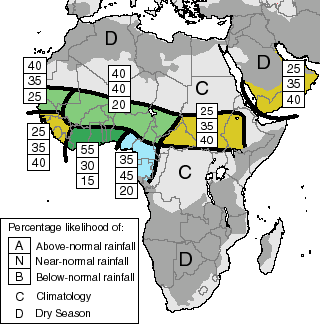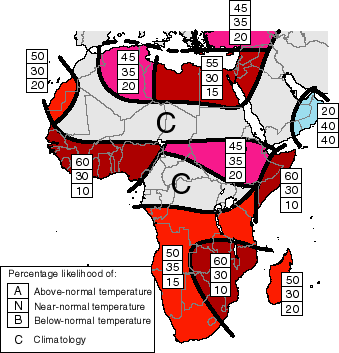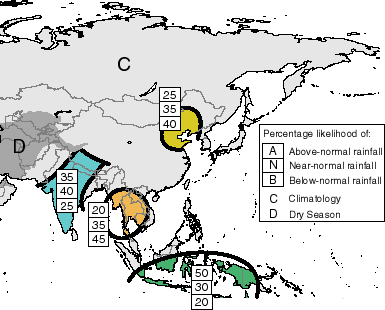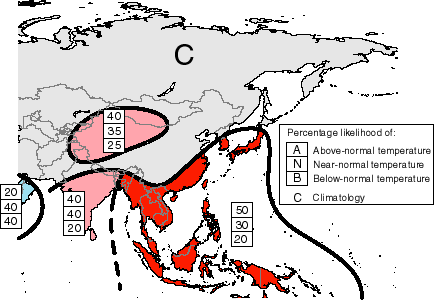IRI NET ASSESSMENT FORECAST
Discussion
In July 1999, the IRI Experimental
Forecast Division prepared a Climate Outlook for July-September 1999.
Of relevance in the preparation of the Outlook have been the weakening
of La Nina conditions (lower than average sea-surface temperatures (SSTs)
in the central equatorial Pacific Ocean). The persistence of slightly warmer
than average conditions in the western Pacific have been assumed also.
The SSTs of the southern tropical Indian Ocean were assumed to remain above
average. The forecast of tropical Atlantic SSTs suggests a continued
warming trend.
Precipitation Outlook
The Outlook for July-September 1999 can also be found at http://iri.columbia.edu/forecast/net_asmt.
Maps are given showing expected precipitation probabilities in tercile
classes. The maps indicate probabilities that seasonal precipitation will
fall into the wettest third of the years (top number), the middle third
of years (middle number) or the driest third of the years (bottom). An
outlook of climatology "C" indicates equal probabilities in each class
i.e.; there is no basis for favoring the forecast of any particular category.
Areas marked "D" experience a pronounced dry season during the forecast
period, typically receiving less than 15% of their annual precipitation
total during this three-month period. Boundaries between sub-regions should
be considered transition zones, and their location considered to be only
qualitatively correct.

July-September 1999 Precipitation Probabilities |
Methods The
following procedures and information were used to prepare this Climate
Outlook: 1) Coupled ocean-atmosphere model predictions of tropical Pacific
SST Particularly heavy weighting has been given to the NOAA /NCEP, Climate
Modeling Branch coupled model , 2) statistical forecasts of Indian Ocean
and Atlantic Ocean sea surface temperature, 3) Atmospheric global circulation
model (GCM) predictions response to the present and predicted SST patterns,
4) Statistical analyses, 5) Appropriate Regional Climate Outlook Forum
consensus guidance.
The procedures, models, and data used to derive this Climate
Outlook may be somewhat different from those used by National Meteorological
Services in particular regions and may differ from the official forecasts
issued in those areas. This Climate Outlook is dependent on the quality
of of the SST predictions. For the tropical Pacific, these predictions
can be expected to provide useful information, but there is some uncertainty
concerning the detailed evolution of SSTs. Spread in global SST predictions
is a source of uncertainty in the Outlook provided here.
It is stressed that the current status of seasonal-to-interannual
climate forecasting allows prediction of spatial and temporal averages,
and does not fully account for all factors that influence regional and
national climate variability. This Outlook is relevant only to seasonal
time scales and relatively large areas; local variations should be expected.
For further information concerning this and other guidance products, users
are strongly advised to contact their National Meteorological Services.

July-September 1999 Temperature Probabilities |
Temperature Outlook
The Outlook for July-September 1999 can also be found at http://iri.columbia.edu/climate/forecast/net_asmt/.
The temperature map show expected probabilities that the seasonal temperatures
will fall into the warmest third of the years
(top
number), the middle third of the years, or the coldest
third of the years (bottom number).
A qualitative outlook of climatology "C" indicates equal probabilities
in each class i.e.; there is no basis for favoring the forecast of any
particular category. Boundaries between sub-regions should be considered
transition zones, and their location considered to be only qualitatively
correct.
| Sources of information
include ACMAD, Caribbean Meteorological Institute, CPTEC, CPC/NOAA, Department
of Natural Resources (Queensland, Australia), ECMWF, Indian Meteorological
Department and the South African Weather Service. |
|




